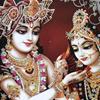In both Mahabharata and Bhagavata, Mohini is referred simply as an enchanting, female form of Vishnu, an avatar for a specific purpose, a momentary one, to deviate the attention of Asurs from Amrit and to distribute the Amrit to Devatas, helping them retain their immortality. But in the later versions, Mohini is described as Maya (illusion) of Vishnu. Once the Mohini legend becomes popular, it was expanded in the added versions of the puranas , retold and re-written and these tales of Mohini-Vishnu gradually gained popularity, in the 10th century onward versions of Mahabharata where Mohini becomes formal Avatar of Vishnu. The most famous and prominent tale of her life is her union with Shiva!! It was mentioned in the Brahmanda Purana and according to Bhagwat Purana, after Vishnu deceives the demons by his Maya, the female form, Shiva wanted to meet her again, so he immediately visited Vishnu along with his wife Parvati, and asked him to take the form of Mohini again. When Vishnu turned himself into a beautiful and seductive lady, Lord Shiva fell for her. Overcome by lust, Lord Shiva ran behind the enchanting Mohini and grabbed her arms and embraced her but she escaped!!!! During her violent coupling, Shiva’s seed fell on the ground and that led to the birth of another God known as Ayyappa! Strictly speaking, Mohini does not have an independent existence, she exists only as a temporary form and is transformed back into Vishnu after serving her purpose. That is why the Vedic scripts never considered her as Vishnu's Avtar.Originally posted by: stormborn
I too thought Mohini was a avatar. So I googled. All sites are saying that the avtars are----- matsya, Kurma, barah, nrisingha, bamana, Rama, parasurama, krishna, balarama/Buddha, Kalki.
The 9th one is not clarified anywhere. This people have already shown balarama as seshnag. So they can't show him as Vishnu. And if it's Buddha, well I don't know why a Narayan incarnation would create another religion other than Hinduism. According to some scholars, the Brahmanical society created the myth of Buddha being Vishnu's incarnation to merge Buddhism with Hinduism as buddism was spreading rapidly and they felt insecure. Anyway we don't need to bother about that here because Radha has to cover only 7 steps. Therefore only 7 incarnations are to be shown. They will stop after parsuram. They didn't show the Amrit story because that didn't include any Krishna incarnation as Mohini is not being considered here.
Now I know very less about mythology. So Madhuri (viswashruti ) is the right person to clarify this. Though I think Swastik people are just following Wikipedia and wiki doesn't include Mohini.
Regarding Buddha as the 9th incarnation of Vishnu--- Buddha was never mentioned as an Avtar of Vishnu in Vedic and puranic scriptures. By adopting Buddha into the Hindu pantheon was a way of trying to neutralize the popularity of Buddhism at that time! Jayadeva, the Geeta Govinda poet included Buddha as the 9th Avtar of Vishnu in his Dasavatara Varnan! [ Description of 10Incarnations of Lord Vishnu]
Nindasi yajna-vidher ahaha shruti-jatam
Sadaya-hrdaya darsita-pasu-ghatham
Keshava dhruta-buddha-sarira jaya jagadisa hare !
Translation--
[Victory to Keshava , the lord of the Universe,
Who assumed the form of Buddha,
Who found fault with fire sacrifices,
In which poor animals were sacrificed,
As prescribed in the Vedas due to his compassionate heart.]
And surprisingly he mentioned Balarama as Lord Vishnu's Avtar --
Vahasi vapusi visade vasanam jaladabham
Hala-hati-bhiti-milita-yamunabham
Keshava dhruta-haladhara-rupa jaya jagadisa hare 8
[Victory to Keshava , the lord of the Universe,
Who assumed the form of Balarama,
Who wore cloths of colour of The River,
Yamuna over his white body and made,
The river fears his weapon of the plough.]
In another Ashtapadi he described Dasavataras like this ---
vedan uddharate jaganti vahate bhugolam udbibhrate
daityam darayate balim chalayate kshatra kshayam kurvate
paulastyam jayate halam kalayate karunyam atanvate
mlecchan murccayate dasaktikrite krishnaya tubhyam namaha
Translation--
“O Krishna, He who accept ten incarnations! I offer my obeisances unto You for saving the Vedic scriptures as Matsya-incarnation; You help up the universe as Kurma-incarnation, and lifted up the world as Varaha, the Boar incarnation; as Nrishimha You vanquished Hiranyakashipu; as Vamana You deceived Bali Maharaja; as Parashurama You exterminated the corrupt warrior class; as Rama You slew Ravana; as Balarama You took up the plough; as Buddha You bestowed compassion, and as Kalki You kill the Mlecchas.”
Adi Shankaracharya, a scholar from the first half of the 8th century CE, played an important part in paving the way for protecting the Vedic culture by using his own imagined philosophy, Mayavada, based on his own interpretation of some of the Vedic stanzas, to defeat Buddhism at that time and later Buddhism with it's similar principles of Hinduism [ Brahminism they called it at that time!] If this Lord Buddha is an incarnation of Lord Vishnu, then Sri Sankaracharya’s connection to Him requires further elaboration and analysis. Adi Sankaracharya never mentioned or accepted Buddha as an incarnation of Vishnu.So there are different versions regarding this matter. It is a vast subject and many researchers followed different paths to establish or to question this theory of Buddha as an incarnation of Lord Vishnu. With my very limited knowledge, I tried my best to tell you only this much.
























comment:
p_commentcount